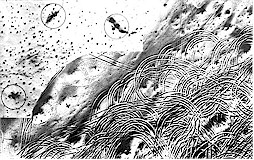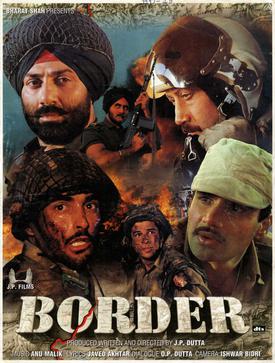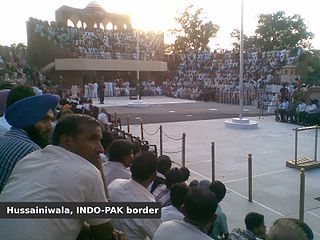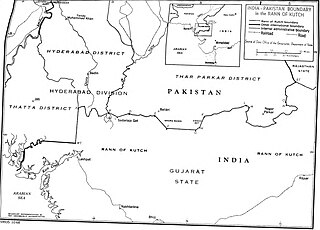
The Border Security Force (BSF) is a central armed police force in India under the Ministry of Home Affairs. It is responsible for guarding India’s borders with Pakistan and Bangladesh. It was formed in the wake of the Indo-Pakistani War of 1965 to ensure the security of India’s borders and for related matters. All officers and subordinate staff are trained at the BSF Academy in Tekanpur near Gwalior in Madhya Pradesh.

The Battle of Longewala was one of the first major engagements in the western sector during the Indo-Pakistani War of 1971, fought between assaulting Pakistani forces and Indian defenders at the Indian border post of Longewala, in the Thar Desert of Rajasthan. The battle was fought between 120 Indian soldiers accompanied by four Hawker Hunter and three HAL Marut fighter-bombers and 2,000–3,000 Pakistani soldiers accompanied by 30–40 tanks.

The Indo-Pakistani war of 1965, also known as the second India–Pakistan war, was an armed conflict between Pakistan and India that took place from August 1965 to September 1965. The conflict began following Pakistan's unsuccessful Operation Gibraltar, which was designed to infiltrate forces into Jammu and Kashmir to precipitate an insurgency against Indian rule. The seventeen day war caused thousands of casualties on both sides and witnessed the largest engagement of armoured vehicles and the largest tank battle since World War II. Hostilities between the two countries ended after a ceasefire was declared through UNSC Resolution 211 following a diplomatic intervention by the Soviet Union and the United States, and the subsequent issuance of the Tashkent Declaration. Much of the war was fought by the countries' land forces in Kashmir and along the border between India and Pakistan. This war saw the largest amassing of troops in Kashmir since the Partition of India in 1947, a number that was overshadowed only during the 2001–2002 military standoff between India and Pakistan. Most of the battles were fought by opposing infantry and armoured units, with substantial backing from air forces, and naval operations.
The Thar Express was an international passenger train that ran between the Bhagat Ki Kothi a suburban area of Jodhpur in the Indian State of Rajasthan and Karachi Cantonment of Karachi in the Pakistani Province of Sindh. The name of the train is derived from the Thar Desert a sub-continental desert, which lies in the north-western part of the Indian subcontinent and ranks 17th in the world covering an area of 200,000 km2 (77,000 sq mi).

India and Pakistan have a complex and largely hostile relationship that is rooted in a multitude of historical and political events, most notably the partition of British India in August 1947.

Border is a 1997 Indian Hindi-language epic war film written, produced and directed by J. P. Dutta. Set during the Indo-Pakistani War of 1971, the film is based on the events of Battle of Longewala (1971). It stars Sunny Deol, Suniel Shetty, Jackie Shroff, Akshaye Khanna, Sudesh Berry and Puneet Issar alongside a supporting cast including Kulbhushan Kharbanda, Tabu, Raakhee, Pooja Bhatt and Sharbani Mukherjee.

The India–Pakistan, Indo–Pakistani is the international boundary that separates the nations of the Republic of India and the Islamic Republic of Pakistan. At its northern end is the Line of Control, which separates Indian-administered Kashmir from Pakistani-administered Kashmir; and at its southern end is Sir Creek, a tidal estuary in the Rann of Kutch between the Indian state of Gujarat and the Pakistani province of Sindh.

The Garhwal Rifles, are an infantry regiment of the Indian Army. It was originally raised in 1887 as the 39th (Garhwal) Regiment of the Bengal Army. It then became part of the British Indian Army, and after the Independence of India, it was incorporated into the Indian Army.

Fazilka, also known as Bangla, is a city and a municipal council in Fazilka district of Punjab, India. In 2011, it was made the headquarter of the newly created Fazilka district. The Trans-Afghanistan Pipeline (TAPI) project originating in Turkmenistan will have its last station in Fazilka.

Hussainiwala is a village near Firozpur city in Firozpur district in Punjab state, India. It lies near the bank of the Sutlej river. The village is on the border with Pakistan, opposite the Pakistani village of Ganda Singh Wala. It is a border crossing between India and Pakistan that is currently closed, however a daily joint beating retreat border ceremony is held by the two nations. The village is popular for the Hussainiwala National Martyrs Memorial.

Camel cavalry, or camelry, is a generic designation for armed forces using camels as a means of transportation. Sometimes warriors or soldiers of this type also fought from camel-back with spears, bows, or firearms.
The 11th Infantry Division is an infantry division of the Indian Army. It was raised as a part of the Indian Army during World War II. It formed part of Indian III Corps in the Malaya Command during the Battle of Malaya. The division was re-raised on 1 April 1965 and is presently part of the XII Corps of Southern Command. It is presently responsible for safeguarding the borders with Pakistan along Southern Rajasthan and Gujarat.
Transport between India and Pakistan has been developed for tourism and commercial purposes and bears much historical and political significance for both countries, which have possessed few transport links since the partition of India in 1947. In 2019, all public transport links between the two countries were severed because of Pakistani protest at India's revocation of the special status of Jammu and Kashmir. The only way for travelers to make this journey is to cross on foot at Wagah.

The Battle of Barki was a battle during the Indo-Pakistani War of 1965 between Indian infantry and Pakistani armour units. Burki is a village, that lies south-east of Lahore near the border with Punjab. For reference, that is just 11 km from the Allama Iqbal International Airport in Lahore, and is connected to Lahore by the a bridge over the Bambawali-Ravi-Bedian (BRB) Canal. During the battle, the strength of the two sides were relatively even. Indian infantry clashed with Pakistani forces that were entrenched in pillboxes, dug-outs and slit trenches that had been carved into the canal banks. The Pakistanis were supported by a large number of tanks, as well as fighter jets. The battle resulted in an Indian victory and withdrawal of Pakistani forces towards Dograi.The Indian Army went on to capture Dograi on 21 September 1965.
Munabao railway station is located in Barmer district in the Indian state of Rajasthan. It is a railway transit point on the India–Pakistan border.
The Marwar Junction–Munabao line connects Marwar Junction, on the Jaipur–Ahmedabad line to Munabao, the last station in India, near the India–Pakistan border. Both are in the Indian state of Rajasthan. There is a link to Jodhpur. This line operates under the jurisdiction of North Western Railway zone.
Gadra Road railway station is a railway station in Barmer district, Rajasthan, India. It used to serve the town of Gadra which is now in Sind province of Pakistan. The station consists of two platforms. The platforms are not well sheltered, and lack facilities including water and sanitation.Country's first railway shaeed smarak is situated in Gadra Road (Munabao) ,Badmer district of Rajasthan.
Bijnot Fort, is a ruined fortress located in Bahawalpur District of Punjab, Pakistan, 23 kilometres west of Indo-Pakistani border in Cholistan Desert.

Operation Desert Hawk was the codename of a military operation planned and executed by the Pakistan Army in the Rann of Kutch area, the disputed area which was under Indian control from the long-standing status quo. The boundary of Rann of Kutch was one of the few un-demarcated boundaries pending since the 1947 partition of India.

The Siege of Kishangarh Fort was a military siege undertaken by the Pakistan Army against the Indian Army at the Kishangarh Fort on the Rajasthan Front of the Second India–Pakistan War in September 1965.


















